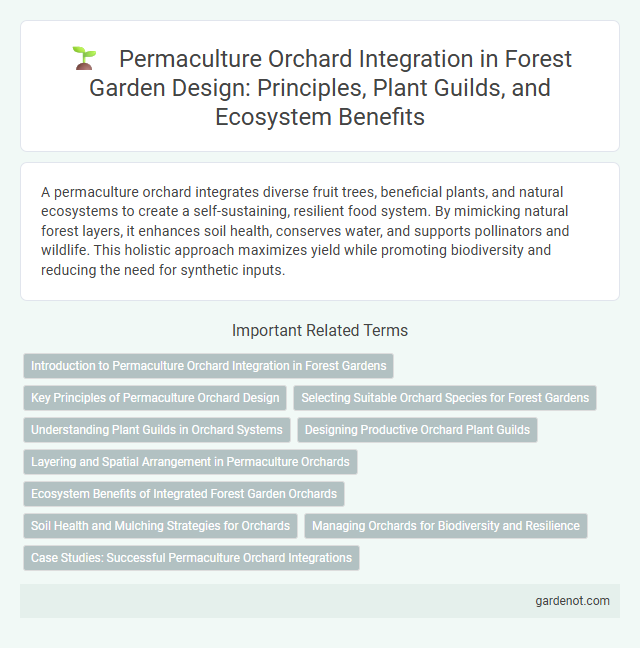A permaculture orchard integrates diverse fruit trees, beneficial plants, and natural ecosystems to create a self-sustaining, resilient food system. By mimicking natural forest layers, it enhances soil health, conserves water, and supports pollinators and wildlife. This holistic approach maximizes yield while promoting biodiversity and reducing the need for synthetic inputs.
Introduction to Permaculture Orchard Integration in Forest Gardens
Permaculture orchard integration enhances forest gardens by combining diverse fruit and nut trees with perennial vegetables and ground covers, creating resilient, self-sustaining ecosystems. This approach maximizes biodiversity, improves soil health, and increases productivity through natural cycles and mutual plant relationships. Incorporating nutrient-fixing species and dynamic accumulators in layers ensures efficient resource use and long-term orchard sustainability.
Key Principles of Permaculture Orchard Design
Permaculture orchard design emphasizes key principles such as biodiversity, soil health, and water conservation to create sustainable, self-sufficient ecosystems. Integrating multiple plant species--including fruit trees, nitrogen-fixing plants, and beneficial ground covers--enhances resilience and maximizes yields. Strategic layering and companion planting optimize space and nutrient cycling, mimicking natural forest systems for long-term productivity.
Selecting Suitable Orchard Species for Forest Gardens
Selecting suitable orchard species for forest gardens involves choosing diverse, native, and perennial plants that complement the local ecosystem while ensuring year-round productivity. Key species often include nitrogen-fixing trees, fruit-bearing shrubs, and understory plants that enhance soil fertility, provide habitat, and reduce pest pressures. Emphasizing biodiversity with species like apple, hazel, elderberry, and comfrey helps create a resilient, self-sustaining permaculture orchard within the forest garden system.
Understanding Plant Guilds in Orchard Systems
Permaculture orchard design centers on understanding plant guilds, which are groups of complementary species that support each other's growth, improve soil health, and enhance pest resistance. In orchard systems, plant guilds typically include a fruit tree as the central element surrounded by nitrogen-fixing plants, dynamic accumulators, ground covers, and insect-attracting species that create a balanced ecosystem. This approach increases biodiversity, promotes sustainable yields, and reduces the need for synthetic inputs by mimicking natural forest ecosystems.
Designing Productive Orchard Plant Guilds
Designing productive orchard plant guilds in a permaculture orchard involves strategically combining complementary plants to enhance nutrient cycling, pest control, and soil health. Key guild components include nitrogen-fixing trees, dynamic accumulators, ground covers, and insectary plants that attract beneficial insects. This method maximizes yield and biodiversity while creating a resilient, self-sustaining orchard ecosystem.
Layering and Spatial Arrangement in Permaculture Orchards
Permaculture orchards utilize strategic layering by integrating canopy, understory, shrub, herb, ground cover, root, and vertical layers to maximize biodiversity and resource efficiency. Spatial arrangement prioritizes plant compatibility and growth habits to optimize sunlight exposure, water retention, and nutrient cycling within limited garden space. This method enhances ecosystem resilience and yields sustainable food production through natural synergies among species.
Ecosystem Benefits of Integrated Forest Garden Orchards
Integrated permaculture orchard systems in forest gardens enhance biodiversity by fostering diverse plant layers that support pollinators, wildlife, and beneficial microorganisms. These ecosystems improve soil health through natural nutrient cycling and increased organic matter, reducing erosion and promoting water retention. The synergy between trees, shrubs, and ground plants creates resilient habitats that contribute to carbon sequestration and climate regulation.
Soil Health and Mulching Strategies for Orchards
Permaculture orchards prioritize soil health through diverse mulching strategies that improve moisture retention, suppress weeds, and enhance microbial activity. Applying organic mulches such as wood chips, leaf litter, and compost creates a nutrient-rich environment, promoting robust root development and resilient tree growth. These mulching practices reduce soil erosion, increase biodiversity, and foster a sustainable ecosystem within the forest garden.
Managing Orchards for Biodiversity and Resilience
Permaculture orchards maximize biodiversity by integrating diverse native plant species, beneficial insects, and natural pest control methods to create a self-sustaining ecosystem. Managing orchards for resilience involves practices such as mulching, companion planting, and adaptive pruning to enhance soil health, water retention, and disease resistance. These strategies promote ecological balance, improve fruit yields, and increase the orchard's ability to withstand climate variability.
Case Studies: Successful Permaculture Orchard Integrations
Permaculture orchards showcase diverse case studies where integrating layered plant species maximizes yield and biodiversity, such as the Beacon Food Forest in Seattle, which combines fruit trees, nitrogen-fixing plants, and ground covers to create a self-sustaining ecosystem. Research from the Canary Islands demonstrates that intercropping apple trees with legumes and herbs reduces pest infestations and enhances soil fertility without synthetic inputs. These successful examples underline the effectiveness of permaculture principles in designing resilient orchards that support both environmental health and food production.
Permaculture orchard Infographic

 gardenot.com
gardenot.com